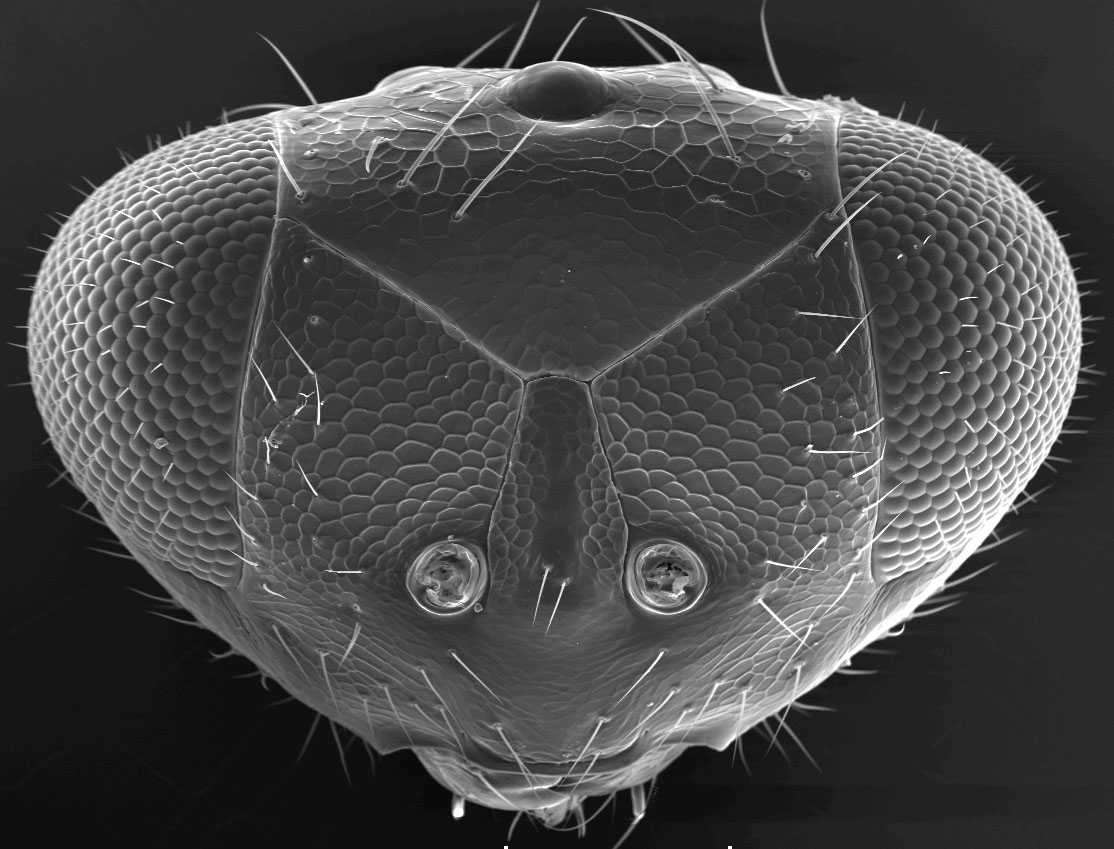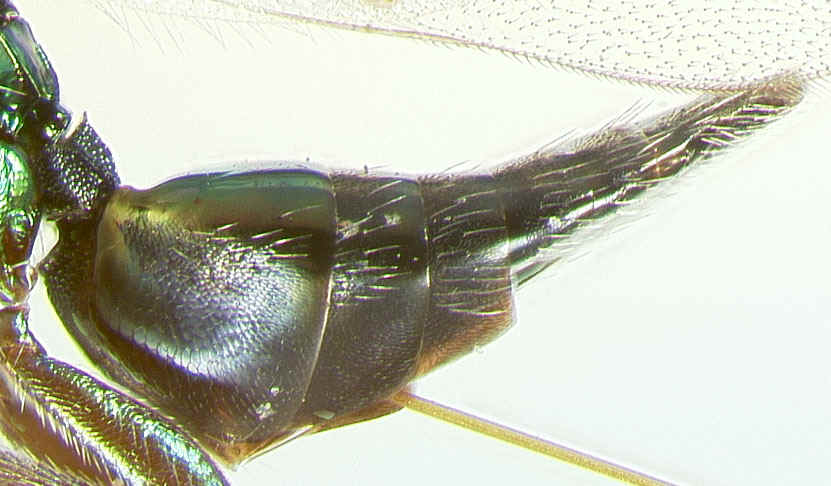1a-b: Pediobius foveolatus (Crawford) mesosomal dorsum (left), and propodeum (right)
return to: Eul 1 Eul 4 eud 1 eul 1 ent 1 ent 5 ent 10 ent 13 ent 16 ent 21 ent 26
Pediobius
Walker, 1846 comparative info return to: prev home
Transverse frontal groove broadly V-shaped, with scrobal grooves present as
distinct sulci and reaching the transverse groove before meeting; vertex carinate
or sharply margined posteriorly, with lateral ocelli distant from the vertex
margin by at least half their own diameter in nearly all species (I have a series of an
exceptional species from Australia). Flagellum with 5 postanellar flagellomeres, with at
least 2 of them as funicular segments and at least 1 as a claval segment. Pronotal
collar at least weakly, usually strongly, carinate;
mesoscutal midlobe with 2 pairs of setae; scutellum without longitudinal groove (but often
with broad smooth area); scutellar-axillar border with or without a distinct dorsal pit;
posterior edge of prepectus overlapped by narrow extension of mesepisternum that is set
off by a dorsal sulcus, but this sulcus is weak in many species; epicnemial carina absent;
metapleuron with a strong, sharply pointed projection. Postmarginal and stigmal veins very
short, several times shorter than the marginal vein; stigmal vein with a very
short stalk, stigma not appearing petiolate. Propodeum with 1 median
carina splitting posteriorly, 2 submedian carinae diverging
posteriorly, raised median strip, or median channel
separating raised submedian panels; anterior portion of median carina without
cup-shaped structure, but sometimes with tooth-like extension; plicae present.
Petiole with anterior flange embracing nuchal apex; with
ventrally-projecting tooth (generally difficult to locate without removing it or a
metacoxa from the body). Gt1 usually covering 0.5x or more of gaster, rigidly convex and
not collapsing when dry, rigid and longer than the other tergites which frequently
telescope inside it in air dried specimens. A few species with greatly enlarged metatibial
spur; first gastral sternite with a strongly sclerotized, reticulate region at the
petiolar base. Compare with: Proacrias, Emersonella,
Edovum, Horismenus, Paracrias, Entedon, Achrysocharoides.
1a-b: Pediobius foveolatus (Crawford) mesosomal dorsum (left), and
propodeum (right)
2a-b: Pediobius propodea: P. adelphae Peck (left), and P.
nigritarsis (Thomson) (right)
3a-b: Pediobius alcaeus (Walker) dorsal view (left), and lateral
view of propodeum (right)


Pediobius face (left), and gaster (right)
Biology:
Comments: Large genus linked with the Horismenus group and Paracrias. The posteriorly split median carina sometimes forms part of a median raised smooth strip, which recalls the median groove of Horismenus, and the mesepisternum has a frequently indistinct special projection set off by a dorsal sulcus and extending to overlap the posterior border of the prepectus, that is a defining apomorphy of the Horismenus genus-group. Also, some species have an apparent pit on the dorsal part (anterior half) of the scutellar-axillar border, another defining apomorphy of the Horismenus group. Less convincing characters that they all share are the very short postmarginal and stigmal veins, very long marginal vein, scrobal grooves present as distinct sulci, and general body form, sclerotization, and sculpture. It is difficult to point out unique apomorphies linking this genus to Paracrias, Emersonella, and especially to Entedon, although they share certain characters mentioned above, such as the scrobal grooves present as distinct sulci and relative lengths of the forewing veins, that are nevertheless highly variable in Entedon and a number of other apparently related genera. All of these genera, except many species of Entedon, also have a strong, sharp projection extending laterally from the metapleuron. I have found this character to be helpful in identification in some cases, but it is too variable to be used as a convincing apomorphy, as it is present in large-bodied Chrysocharis as well, but absent from most species of that genus.
Comparative information:
Proacrias: Upper mesepimeron without extension over posterior border of prepectus. First gastral tergite collapsing in air-dried specimens, not more rigid than the other tergites. First gastral sternite without the ventral punctulate region at petiolar base.
Emersonella: Propodeum with semicircular submedian carinae, most broadly separated in middle of propodeum; anterior ends of the submedian carinae arising from broad pits or sunken areas with longitudinal rugae extending from the anterior propodeal margin. Face almost always entirely smooth. Transverse frontal groove nearly straight; scrobal grooves uniting before reaching transverse groove. Only resembling Pediobius in having a pair of submedian propodeal carinae, differing strongly in other features, including superficial aspects of body form and sculpture.
Edovum: Petiole with longitudinal ribs. Scutellum with median longitudinal groove; epicnemial carina present, extending from posterior edge of mesepisternal extension.
Horismenus: Vertex not carinate (though rarely with a small transverse ruga at the top of the rounded vertex). Scutellum with longitudinal groove in most species. Propodeum always with broad, smooth, raised median strip flanked by sunken channels, never with submedian or median carinae.
Paracrias: Petiole without dorsal flange. Lateral ocelli in all species very close to the vertex margin. Scrobal grooves uniting before reaching transverse frontal groove. Pronotal collar never carinate. Propodeum almost always with broad, smooth, raised median strip flanked by sunken channels; nucha long and conspicuous and/or propodeum divided into anterior and posterior halves by a distinct cross-carina, the posterior half rugulose in contrast to the mostly smooth anterior half.
Entedon: Propodeum with single narrow median carina placed in a more or less distinct recessed channel; plicae absent; channel between median panels and supracoxal flange crossed by distinct costulae. Scrobal grooves (when distinct) uniting before reaching transverse frontal groove.
Achrysocharoides: Some species have paired propodeal carinae, but differ from Pediobius in that they have a much smaller petiole without an anterior flange. Very few species with a pronotal collar or propodeal plicae.
References
Boucek, Z. 1965. Studies of European Eulophidae, IV: Pediobius Walk. and two allied genera (Hymenoptera). Acta Entomologica Musei Nationalis Pragae. 36: 5-90.
Hansson, C. 2002. Eulophidae of Costa Rica (Hymenoptera: Chalcidoidea), 1. Memoirs of the American Entomological Institute 67.
Peck, O. 1985. The taxonomy of the Nearctic species of Pediobius (Hymenoptera: Eulophidae), especially Canadian and Alaskan forms. Canadian Entomologist. 117: 647-704.
Schauff, M.E. 1991. The Holarctic genera of Entedoninae (Hymenoptera: Eulophidae). Contributions of the American Entomological Institute 26.
Image credits: 1a-b, 3b: Schauff (1991). 2a-b, 3a: Boucek (1965).